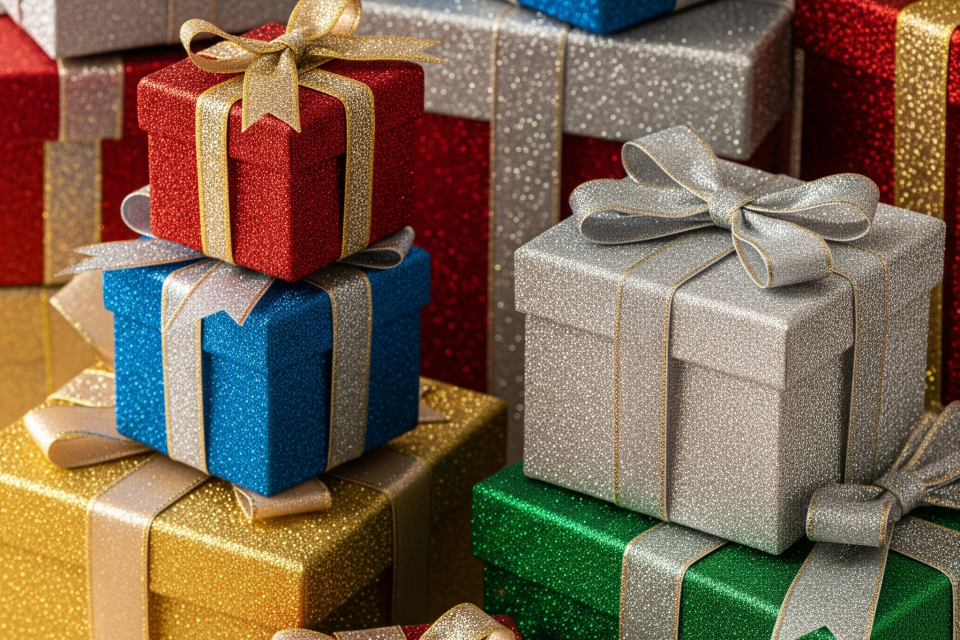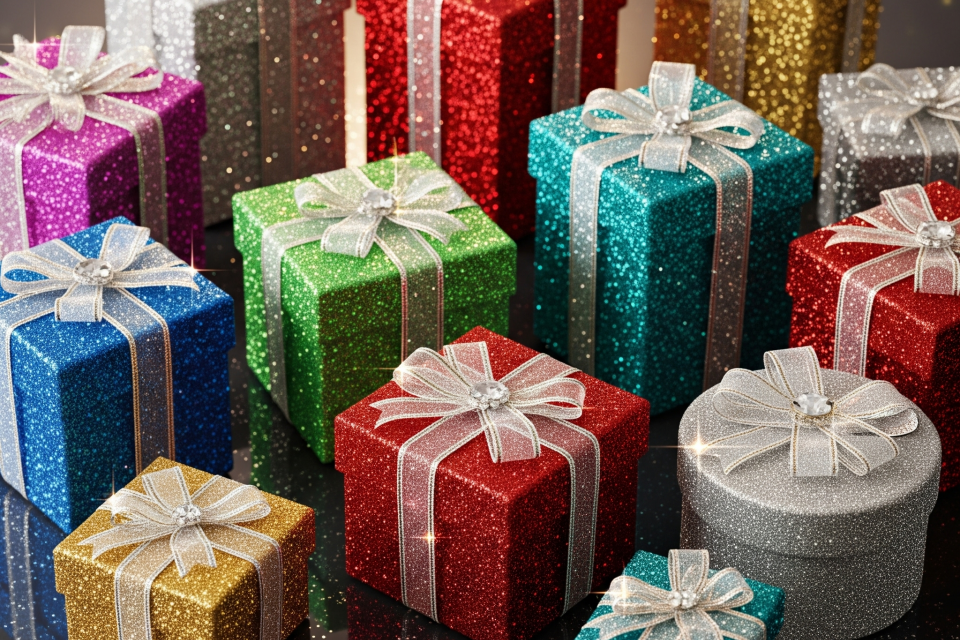Using Glitter and Sparkle in Packaging
Using Glitter and Sparkle in Packaging
Summary
Using glitter and sparkle in packaging is a design trend that enhances the visual appeal and marketability of products across various industries, particularly in cosmetics, fashion, and consumer goods. The incorporation of glitter not only attracts consumer attention but also serves as a powerful tool for brand differentiation in a competitive marketplace. As consumers increasingly seek unique and engaging packaging, brands leverage glitter to create memorable unboxing experiences that resonate with emotional connections and brand loyalty.
Historically, glitter has roots dating back to prehistoric times, with ancient cultures utilizing shimmering materials for decorative purposes. The modern form of glitter, developed in the 1930s, revolutionized its applications and led to its widespread use in multiple sectors, including packaging. Today, glitter is available in various types, each designed to achieve specific aesthetic effects, making it a versatile element in packaging design. However, the rise of glitter in consumer products has also sparked significant environmental concerns, particularly due to its microplastic composition, which contributes to pollution in aquatic ecosystems and poses risks to wildlife.
As public awareness regarding sustainability grows, many brands are pivoting towards eco-friendly alternatives, including biodegradable glitter made from natural materials. This shift reflects a broader trend in consumer preferences towards responsible sourcing and environmental consciousness, prompting the glitter industry to innovate while addressing ecological impacts. The evolving landscape of packaging design highlights the balance between maintaining aesthetic appeal and prioritizing sustainability, illustrating the ongoing dialogue between creativity and environmental stewardship in contemporary consumer culture.

History
Ancient Origins
Glitter has a rich history that dates back to prehistoric times, where it was crafted from various materials including stones like malachite and mica, as well as insects and glass. The use of glitter-like substances has been documented in ancient cultures for decorative and ceremonial purposes. For instance, archaeological findings suggest that the Neanderthals utilized materials for personal adornment, possibly akin to glitter. Additionally, ancient Maya civilizations employed a form of glitter paint to embellish their temples, showcasing its significance in artistic expressions during antiquity.
Modern Development
The modern iteration of glitter emerged in the 1930s when machinist Henry Ruschmann invented a method to create glitter from repurposed materials. His breakthrough came in 1934, when he discovered that by cutting Mylar film into tiny pieces and coating them with metallic powder, he could produce a shimmering substance that would later become synonymous with decorative applications. This innovation led Ruschmann to establish Meadowbank Inventions, which remains one of the largest producers of glitter today.
Expanding Uses
Since the 1940s, the applications of glitter have diversified significantly. While initially associated with arts and crafts, glitter is now a staple in various industries, including cosmetics, fashion, and even forensic science. It is used in makeup to enhance visual appeal, with many products incorporating glitter elements to create eye-catching effects. Moreover, glitter has found its way into more unconventional uses, such as tracking animal movements in ecological studies and visualizing germ spread in educational settings.
Environmental Concerns
Despite its popularity, the production of glitter poses environmental challenges, particularly due to its microplastic composition. Most modern glitter is made from plastic and aluminum, which are not easily recyclable and can contribute to pollution in aquatic environments. This has prompted calls for the reduction or banning of plastic glitter, leading to a growing interest in sustainable alternatives and innovations within the glitter industry.
As consumer awareness of environmental issues increases, the glitter industry is evolving to address these challenges, focusing on sustainable practices while maintaining the aesthetic appeal that has captivated users for centuries.
Types of Glitter
Glitter is available in a diverse array of types, each designed for specific aesthetic effects and applications. The various types of glitter differ primarily in particle size, shape, and reflective properties, allowing for unique visual outcomes in crafts, packaging, and cosmetics.
Common Types of Glitter
-
Description: This type consists of ultra-small particles that create a smooth, uniform sparkle.
- Best For: It is ideal for intricate designs, tumblers, and resin art projects due to its subtle shimmer and even coverage.
-
Description: Chunky glitter features larger particles that produce a bold and dramatic sparkle.
- Best For: It is often used in statement pieces, DIY décor, and nail art, where a more pronounced glitter effect is desired.
-
Description: This glitter shifts colors with the light, offering a stunning rainbow effect.
- Best For: Holographic glitter is perfect for adding a futuristic or magical touch to any project.
-
Description: Made from translucent particles, iridescent glitter gives off a soft, colorful glow.
- Best For: It is well-suited for subtle designs, such as snowflakes or fairy wings, enhancing the ethereal quality of crafts.
-
Description: These are unique combinations of different glitter types, tailored to achieve specific visual effects.
- Best For: Custom blends allow for personalized projects and unique creative expressions, making them popular in various art applications.
Material Composition and Environmental Impact
The majority of glitter is manufactured from plastics such as polyethylene terephthalate (PET) or polyvinyl chloride (PVC), often coated with aluminum to enhance its reflective qualities. This composition results in glitter being classified as a microplastic, raising environmental concerns regarding pollution and its effects on aquatic habitats. As a response to these concerns, recent developments have introduced biodegradable alternatives made from natural materials like cellulose derived from eucalyptus trees and wood pulp.
Understanding the different types of glitter and their applications is essential for maximizing their visual impact while also considering their environmental footprint.

Design Considerations
Visual Appeal and Color Psychology
Incorporating glitter and sparkle in packaging design significantly enhances its visual appeal, making products more attractive to consumers. Research indicates that the visual elements of packaging—such as color, typography, and imagery—play a crucial role in capturing attention and conveying brand identity. Color preferences can evoke specific emotions; for instance, warm colors like red and orange generally elicit feelings of happiness and energy, while cooler tones can project calmness and trust. Understanding the psychological implications of color can guide brands in selecting palettes that resonate with their target demographics.
Texture and Finishes
Textured finishes, such as matte, glossy, or embossed surfaces, can also influence consumer perceptions of quality and luxury. The choice of finish, combined with glitter elements, can enhance the tactile experience, prompting consumers to engage more deeply with the product. This is particularly effective in creating a memorable unboxing experience, which is critical in e-commerce contexts where physical interaction with the product is limited.
Functionality and User Experience
While aesthetic considerations are vital, packaging must also prioritize functionality. Effective design includes practical features such as ease of opening, resealable elements, and space-efficient shapes. These functional aspects contribute to a positive user experience and reinforce brand perception by demonstrating attention to detail and customer needs. For brands aiming to reduce unnecessary packaging, balancing aesthetics with accessibility becomes essential, especially in accommodating consumers with visual impairments.
Authenticity and Brand Values
In today's market, authenticity is paramount. Consumers increasingly seek products that reflect their values, including sustainability and ethical sourcing. Packaging that communicates a brand's commitment to these principles—through the use of eco-friendly materials or transparent messaging—can foster trust and loyalty among consumers. Integrating glitter and sparkle into sustainable packaging can convey a sense of fun and luxury while aligning with modern consumer expectations for environmental responsibility.
Storytelling Through Design
Every package has a story, and effective packaging design serves as a platform for narrative. Brands can leverage the allure of glitter and sparkle to convey their unique stories, whether it's the inspiration behind the product or the journey of its creation. This storytelling adds depth to the consumer experience, creating emotional connections that can drive brand loyalty and repeat purchases.
Strategic Differentiation
As market competition intensifies, standout packaging is essential for brand differentiation. By utilizing vibrant colors, unique textures, and eye-catching glitter elements, brands can command attention and succinctly convey their message to consumers. This strategic approach not only enhances product visibility but also reinforces brand personality and identity, positioning the brand favorably within its market segment.
Applications in Various Industries
Fashion and Apparel
The fashion and apparel industry is another significant consumer of glitter, using it to create eye-catching details and embellishments that transform ordinary clothing into dazzling works of art. From glittering evening gowns to sparkling accessories and footwear, glitter plays a prominent role in making fashion statements. Designers are constantly innovating, driven by evolving trends, which keeps the demand for glitter strong across various fashion segments.
For B2B e-commerce sellers, supplying glitter to clothing manufacturers and designers presents a lucrative opportunity. Platforms like Alibaba.com facilitate connections between sellers and buyers in the fashion sector, making it easier to cater to the creative needs of designers looking to incorporate glitter into their collections.
Cosmetics and Beauty
Glitter is a staple ingredient in the cosmetics and beauty industry, commonly used in products such as eyeshadows, lip glosses, nail polishes, and body shimmers. Its ability to add sparkle and allure has made it indispensable for cosmetics manufacturers, driving a surge in demand for glitter-infused cosmetics due to current beauty trends. Additionally, glitter is increasingly finding its way into self-care products like soaps, bath balms, and massage oils, expanding its appeal beyond traditional makeup.
With the rising trend towards clean beauty, many brands are now prioritizing transparency in their ingredients, leading to the introduction of "eco-friendly" glitters made from plant-based or mineral-based materials. These alternatives aim to minimize the environmental impact while satisfying consumer demand for safer and cleaner products, particularly among those with allergy-prone skin. The beauty industry's ongoing adaptation to consumer preferences for sustainability further illustrates the significance of glitter in enhancing product appeal and meeting market demands.
Packaging Innovations
The use of glitter is also prevalent in packaging for cosmetics and beauty products. Shimmering packaging not only enhances the visual appeal of products but also serves as a marketing tool, attracting consumers in a competitive marketplace. Bold and vibrant packaging designs are becoming essential for brands aiming to stand out, particularly among younger demographics who favor unique aesthetics. The integration of glitter into packaging reflects broader consumer trends towards eye-catching designs that effectively engage and draw in potential buyers.
As companies increasingly leverage glitter in their marketing strategies, the interplay between innovative packaging designs and consumer engagement metrics becomes crucial in driving sales and brand loyalty. The emotional and visual impact of glittery packaging can significantly influence purchasing behavior, making it an essential element in the marketing of beauty and fashion products.
Environmental Impact
The use of glitter in packaging and products has garnered increasing scrutiny due to its significant environmental repercussions. Glitter microplastics, which are prevalent in both marine and terrestrial environments, are a substantial contributor to plastic pollution, with studies indicating that they can disrupt aquatic ecosystems and pose risks to wildlife and human health. Microplastics are tiny particles, typically less than 5 mm in size, that can be ingested by marine organisms, leading to malnutrition and internal injuries. Research highlights that glitter can be particularly harmful, as it is often mistaken for food by marine life, contributing to broader issues within the food chain.
Despite some glitters marketed as "eco-friendly," studies have found that these alternatives may still carry negative environmental impacts. The chemical additives used in the production of conventional glitter pose additional health risks, contaminating soil, air, water, and food supplies, leading to various medical conditions and impairments in immune and reproductive systems. Moreover, microplastics can act as carriers for toxic pollutants, increasing their toxicity when ingested by both marine and terrestrial organisms.
In response to growing concerns regarding the environmental footprint of plastic products, numerous regions have begun implementing legislation aimed at reducing plastic pollution. For instance, California passed a ban on single-use plastic bags, and the U.S. Congress enacted the Microbead-Free Waters Act of 2015 to eliminate microbeads in cosmetics. As public awareness of glitter's role as a pollutant increases, the potential for local legislative action against glitter and similar products is becoming more pronounced.
The demand for greener alternatives is also on the rise, with consumers increasingly favoring biodegradable glitter made from natural materials like plant cellulose. This shift is driven by heightened consumer awareness and a desire for products that align with sustainable practices. Environmental experts argue that adopting such alternatives is essential for mitigating the ecological damage associated with traditional glitter. As brands reassess their strategies in light of these trends, innovations that blend aesthetic appeal with eco-friendly materials are becoming increasingly prevalent in the packaging industry.

Case Studies
Influence of Packaging on Consumer Perception
Various studies have highlighted the critical role packaging plays in shaping consumer perceptions and behavior. One notable investigation focuses on the impact of psychological distance on the believability of claims made on product packaging. This research indicates that packaging design significantly influences consumer trust and product evaluation, making it an essential factor for brands to consider during the design phase.
In a specific study titled "Light and Pale Colors in Food Packaging," researchers found that the aesthetics of packaging, including color, greatly affect consumers' assumptions about a product's taste and healthiness. The results indicated that healthiness evaluations were influenced by package color, even after consumers had tasted the product, demonstrating the subconscious associations tied to packaging design. Furthermore, Charles Spence, an experimental psychology professor, has conducted numerous studies proving that colors and materials in packaging can alter taste perception. For instance, a strawberry mousse presented in a white container was rated 10% sweeter than the same mousse served in a black container.
Cosmetic Packaging and Perceived Quality
Another case study investigates the relationship between cosmetic packaging and perceived price and quality. This research involved a survey of women who regularly purchase cosmetics, revealing that consumers could distinguish between high-end and low-end products based solely on packaging. The study emphasizes that packaging often forms the first impression of a product, influencing the consumer's perception of quality in a retail environment.
Trends in Eco-Friendly Glitter
The rise of eco-friendly glitter in both the cosmetics and events industry provides another compelling case study. As awareness of environmental issues increases, manufacturers are innovating biodegradable glitter options to meet consumer demands for sustainability. This shift is reflected in the fashion and events sectors, where designers are now incorporating these eco-friendly alternatives into their collections, showcasing that sustainable products can also be glamorous.
Moreover, market analysis indicates that organizations focusing on sustainability and customization in glitter products are well-positioned for growth. The trend toward biodegradable glitter not only responds to consumer preferences but also aims to reduce the environmental impact of traditional glitter, which is known to contribute significantly to microplastic pollution.
The Psychological Impact of Visual Appeal
The psychological intricacies of packaging design extend beyond aesthetics to the emotional connections forged with consumers. Effective packaging creates an immersive experience, shaping perceptions and fostering brand loyalty. This concept is illustrated by the idea that the visual appeal and storytelling aspects of packaging can significantly influence consumer choices from the initial glance to the final purchase decision. Brands that successfully integrate these elements into their packaging strategies often enjoy enhanced market presence and consumer engagement.
Future Trends
The future of glitter and sparkle in packaging design is poised for significant evolution, driven by advancements in technology, changing consumer preferences, and increasing demand for sustainable practices. The global packaging industry is projected to witness a surge in the use of glitter, particularly biodegradable options, which align with broader sustainability trends. This sector is expected to experience a promising compound annual growth rate (CAGR) from 2026 to 2033, fueled by rising consumer awareness regarding environmental impact and a shift towards eco-friendly materials.
Sustainability in Glitter Packaging
The integration of biodegradable glitter into packaging materials reflects a growing consumer preference for environmentally responsible products. Companies are innovating by creating glitter that not only enhances visual appeal but also meets sustainability criteria. The movement towards eco-friendly packaging solutions is evident as brands recognize the importance of reducing their environmental footprint while attracting eco-conscious consumers. This trend is particularly evident in major urban centers such as Toronto, Vancouver, and Montreal, where the demand for sustainable products is on the rise.
Innovative Design Trends
As we look toward 2024, the packaging landscape is increasingly characterized by bold and vibrant designs that utilize glitter and other eye-catching elements. Companies are experimenting with various glitter textures, finishes, and particle sizes to create unique visual experiences that resonate with younger generations, such as Millennials and Generation Z, who value both aesthetics and authenticity. This inclination towards innovative packaging is complemented by advancements in materials, allowing for more intricate and diverse uses of glitter in both decorative and functional capacities.
Consumer Engagement and Market Dynamics
The intersection of glitter in packaging design and consumer engagement is becoming more pronounced. As brands seek to differentiate themselves in crowded markets, the use of striking glitter designs can enhance product visibility and foster brand loyalty. The growing demand for products that align with sustainability values is causing brands to reassess their packaging strategies, moving towards innovative designs that communicate both vibrancy and environmental responsibility. As packaging continues to evolve, the response from consumers regarding the integration of glitter will likely shape future trends within the industry.
